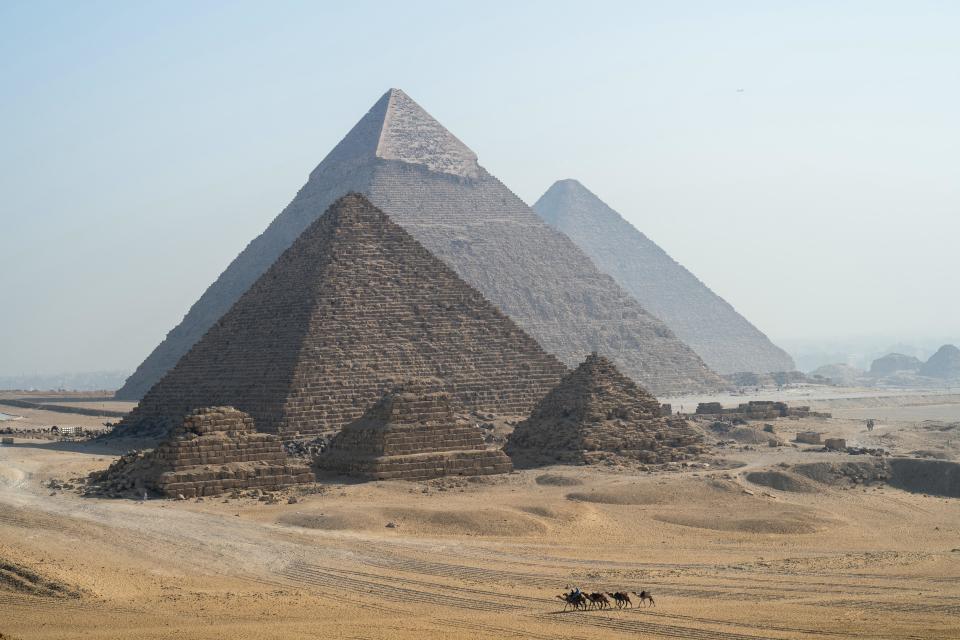Scientists have discovered a long buried branch of the Nile river that once flowed alongside more than 30 pyramids in Egypt, which could solve the mystery of how the ancient Egyptians transported the huge blocks stone to build the famous monuments.
The 40-mile-long branch of the river, which held Giza’s iconic pyramid complex among other wonders, was hidden under desert and farmland for thousands of years, according to a study that revealed the discovery Thursday.
The river explained why the 31 pyramids were built in a chain along an inhospitable stretch of desert in the Nile Valley between 4,700 and 3,700 years ago.
The strip near the ancient Egyptian capital of Memphis includes the Great Pyramid of Giza – the only surviving structure of the seven wonders of the ancient world – as well as the pyramids of Khafre, Cheops and Mykerinos.
Archaeologists have long thought that the ancient Egyptians must have used a nearby waterway to move the massive materials used to build the pyramids.
“But no one was sure about the location, shape, size or proximity of this mega waterway to the location of the actual pyramids,” lead study author Eman Ghoneim from the University of North Carolina Wilmington in the United States told AFP.

The international team of researchers used radar satellite images to map the branch of the river, which they called Ahramat — “pyramids” in Arabic.
Radar gave them the “unique ability to penetrate the sand surface and produce images of hidden features including underground rivers and ancient structures,” Ghoneim said.
The presence of the river was confirmed by field surveys and sediment cores from the site, according to the study in the journal Communications Earth & Environment.
The once mighty river was covered more and more in sand, which may have started during a great drought around 4,200 years ago, the scientists suggested.
“It’s easier to swim down the river”
The Giza pyramids stood on a plateau about a kilometer from the river bank.
Many of the pyramids had a “ceremonial elevated walk” that ran alongside the river before ending at the Valley Temples that served as harbors, Ghoneim said.
This shows that the river “played a central role in transporting the massive building materials and workers needed for the construction of the pyramid,” she said.
How the ancient Egyptians managed to build such large structures for so long is one of the great mysteries of history.
These heavy materials, most of which were from the south, “would be much easier to float down the river” than transport over land, study co-author Suzanne Onstine from the University of Memphis told AFP.
The banks of the rivers may have been where the pharaohs’ funeral fans were found before their bodies were moved to their “final burial place within the pyramid,” she suggested.
The river may also indicate why the pyramids were built in different spots.
“The course of the water and its volume changed over time, so the kings of the fourth dynasty had to make different choices than the kings of the 12th dynasty,” she said.
“The discovery reminded me of the close connection between geography, climate, environment and human behavior.”
The study comes on the heels of recent research projects focusing on the iconic pyramids.
Earlier this year, archaeologists launched a a huge projectt return the smallest of the three famous pyramids of Giza to what they believe it looked like when it was built more than 4,000 years ago. An Egyptian-Japanese archaeological mission has announced the project to return hundreds of granite blocks used to create the outer casing of King Menkaure’s pyramid.
However, some archaeologists, including the former head of Egypt’s antiquities ministry, are not on board with the project, and have expressed concern as the dig continues. Dr. Mohamed Abd El-Maqsoud, former Director of Egypt’s Antiquities Department and former senior official in Egypt’s antiquities ministry, told CBS News that before the granite blocks are moved, they should first be extensively studied to to verify that they were all even involved. of the structure first.
Last year, a team of archaeologists and other scientists in Egypt used cutting-edge technology that relies on radiation from space to get a clear picture of a 30-foot-long. a corridor within the Great Pyramid of Gizawhich is still hidden behind a main entrance to the ancient structure.
Ahmed Shawkat contributed to this report.
Woman attacked by bull on Mexican beach after ignoring warning
Pope Francis blessing same-sex couples
Morehouse College prepares for potential disruption ahead of Biden’s inaugural address